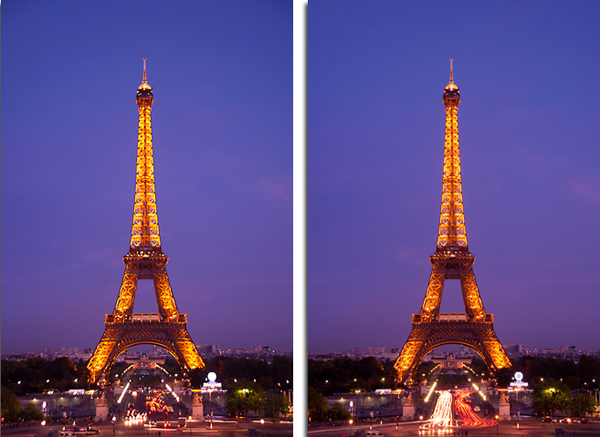The Eiffel Tower is arguably the most photographed monument in all of Europe – if not the world. Paris continues to hold the top spot as the world’s number one travel destination and for many that trip to Paris is a once in a lifetime experience so all the more reason to come back with the most compelling exposures and compositions possible! And one sure way to do just that is to embrace the simple law that every scene before you offers up no less than six possible correct exposures! And when shooting dusk scenes in the city or along the ocean where crashing surf smashes against the rocks, the longer the shutter speed, the better, and when I say longer I am talking seconds – FULL seconds, not fractions of seconds – and that also means the need for a tripod.
Compare the two photos above, both the same exposure in terms of their quantitative value yet notice the obvious and very strong visual difference between the two compositions. The traffic flow in the first image (above, left) is ‘abrupt’, cut short by a ‘fast’ exposure of f/5.6 at a ½ second shutter speed. Compare this to the second image (above, right) where an exposure of f/22 at 8 seconds took place-both are correct exposures in their quantitative value, but radically different in their visual presentation. You be the judge, but I would be very surprised IF you were more fond of the first image with the somewhat abrupt traffic flow. The lesson to be learned here is a simple one; how much motion you record in a given scene is 100% dependent on the which of the six possible correct exposures you choose to use-in this case, the longest possible exposure time seemed to be the better choice! Trial and error are an important and vital part of photographic excellence, so don’t be afraid to experiment with various combinations of apertures and shutter speeds. (Don’t confuse this exercise with ‘bracketing’. Bracketing refers to shooting several additional exposures that are over and/or under exposures of what the meter suggests is correct. ) The above exercise is merely about exploring six possible ‘same’ exposures and their various visual effects.
Check out the video below!
You Keep Shooting!
Bryan F. Peterson/Founder BPSOP











